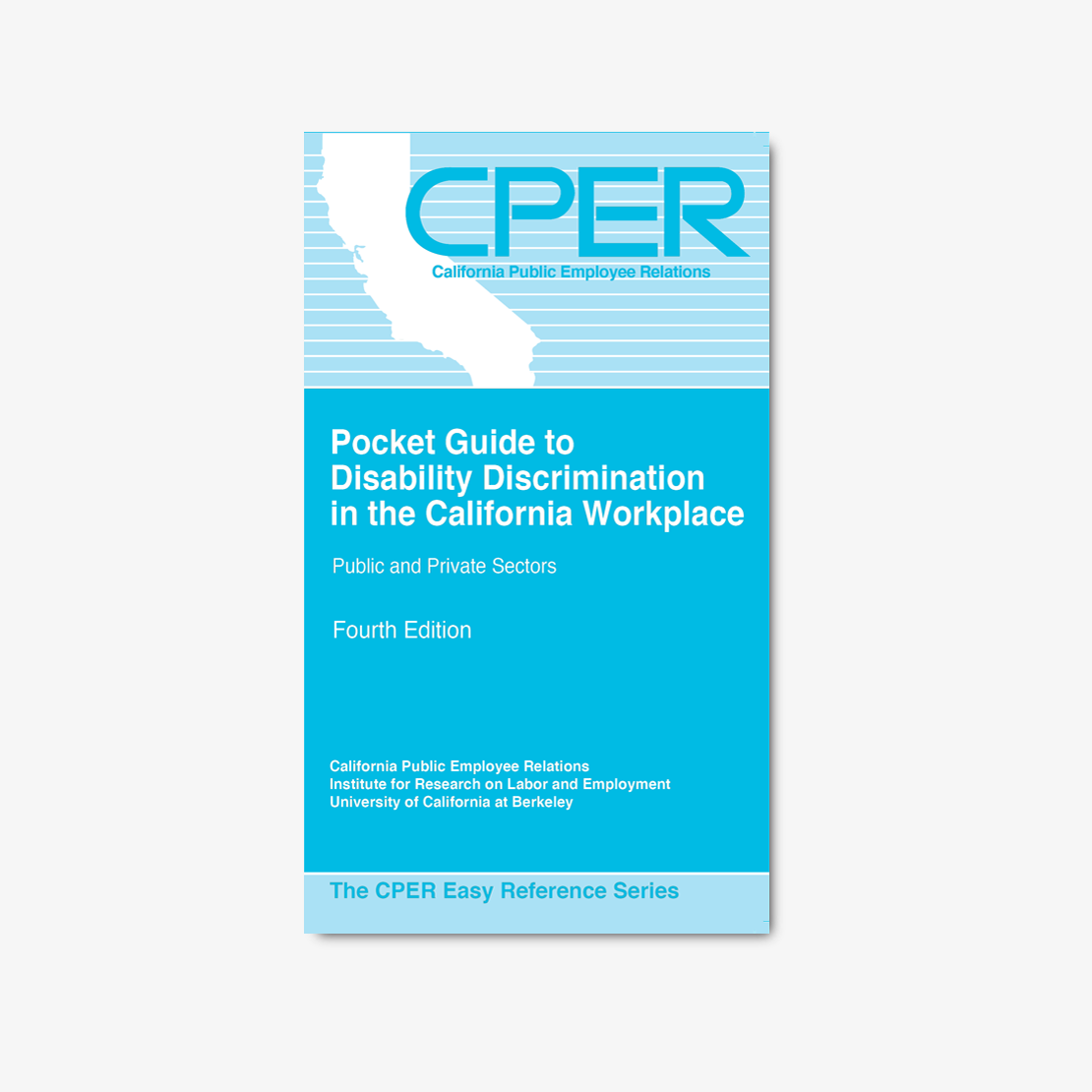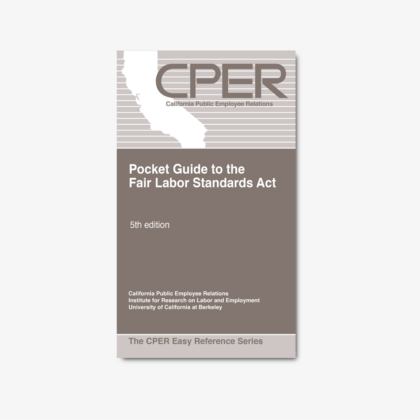The new edition includes up-to-date information concerning:
- Similarities and differences between the FEHA and the ADA, including a chart that compares the key provisions of the laws
- References to the text of the law and the enforcing agencies’ regulations that implement the statutory requirements
- A discussion of other legal protections afforded disabled workers, such as the federal Rehabilitation Act of 1973, the federal Family and Medical Leave Act and corresponding California Family Rights Act, and workers compensation laws
- Major court decisions that interpret disability laws
The guide is a valuable reference and training tool, and helpful to anyone who needs to understand disability discrimination laws that apply in both the public and private sectors in California.
M. Carol Stevens, currently the executive director of CALPELRA, has practiced employment and labor relations law for public agencies in California since 1978. One of the leading legal practitioners in the field of public employment law, Stevens advises employers in nearly all facets of labor relations and employment litigation. She has represented public employers in grievance and interest arbitrations, PERB proceedings, state/federal courts, and other administrative procedures. Stevens is well known for creatively resolving difficult and complex labor relations disputes.
This edition of the disability discrimination guide was revised by Katy Suttorp and Kelly Trainer, partners at Burke, Williams and Sorensen, LLP, who were contributing authors to the 2011 and 2015 editions as well. Both Suttorp and Trainer are based in Burke’s Orange County office, and represent public and private sector employers in all aspects of labor and employment law, including disability discrimination, the interactive process, harassment, leaves of absence, PERS/STRS, and employee discipline. Both also serve as labor negotiators and workplace investigators, and are frequent lecturers on a variety of labor and employment law matters.
Coauthors Sheila Delshad, and Malaika Billups, are associate attorneys with Burke, Williams & Sorensen’s employment law group.
Table of Contents
- Introduction (Page 1)
- How Do the FEHA and ADA Compare? (Page 4)
- Which Employers Do the Laws Cover? (Page 22)
- Which Employers Does the FEHA Cover? (Page 22)
- Which Employers Does the ADA Cover? (Page 23)
- Whom Do the Disability Laws Protect? (Page 25)
- What Are Covered Disabilities Under the Laws? (Page 27)
- What Is the Definition of “Disability” Under the FEHA? (Page 27)
- What Are Major Life Activities Under the FEHA? (Page 30)
- Is working a major life activity under the FEHA? (Page 30)
- When Does a Physical or Mental Condition Limit a Major Life Activity Under the FEHA? (Page 31)
- Does the FEHA consider mitigating measures in determining whether a major life activity is limited? (Page 31)
- Does the FEHA recognize impairments that are temporary as capable of limiting a major life activity? (Page 32)
- What Are Major Life Activities Under the FEHA? (Page 30)
- What Is the Definition of Disability Under the ADA? (Page 33)
- What Is a “Physical or Mental Impairment” Under the ADA? (Page 36)
- What Is a “Major Life Activity” Under the ADA? (Page 38)
- Is working a major life activity under the ADA? (Page 40)
- How Does an Impairment “Substantially Limit” a Major Life Activity Under the ADA? (Page 42)
- When Do the Laws Protect Persons Who Not Have an Actual Disability, and Never Have? (Page 49)
- Regarded as Having a Disability (Page 49)
- Associates of Disabled Individuals (Page 51)
- Other Individuals (Page 51)
- What Is the Definition of “Disability” Under the FEHA? (Page 27)
- What is an Essential Function and Its Impact on “Working”? (Page 53)
- How Does Protection Under the Laws Depend on a Person Being “Qualified”? (Page 53)
- How Do the Laws Define “Essential Functions” or Purposes of Determining Whether an Individual Is “Qualified”? (Page 58)
- What Is the Employer’s Obligation to Engage in the Interactive Process and Provide Reasonable Accommodation? (Page 59)
- Does the Employee Require “Reasonable Accommodation”? (Page 59)
- When Must Employers Engage in an Interactive Process? (Page 67)
- Is a Public Sector Employee Entitled to Union Representation During the Interactive Process? (Page 69)
- What Medical Information May Employers Request in an Interactive Process? (Page 70)
- How Should Employers Identify Possible Accommodations in an Interactive Process? (Page 72)
- When May Employers Refuse to Accommodate an Employee? (Page 75)
- What Other Obligations Do Employers Have in Complying with Disability Discrimination Laws? (Page 79)
- What Obligations Does the ADA Impose on Employers? (Page 79)
- What Obligations Does the FEHA Impose on Employers? (Page 80)
- What Practices Do the Laws Regulate During the Pre-Employment Process? (Page 81)
- Job Announcements and Job Training Programs (Page 81)
- Administering Tests and Accommodating Test-Takers (Page 83)
- Physical agility tests (Page 83)
- Drug tests (Page 83)
- Pre-Employment Medical Exams and Inquiries (Page 85)
- What questions may employers ask job applicants? (Page 86)
- What limitations do employers have in making medical inquiries and requiring medical examinations for applicants? (Page 88)
- Confidential Medical Files (Page 89)
- What Practices Do the Laws Regulate During Employment? (Page 90)
- Work Rules (Page 90)
- Drug Use (Page 92)
- Alcohol Use (Page 96)
- Workplace Rules Regarding Substance Abuse (Page 97)
- Employee Medical Exams and Inquiries (Page 98)
- Retirement and Health Care Plans (Page 99)
- Retirement plans (Page 99)
- Medical plans (Page 100)
- Safe harbor (Page 101)
- What Post-Employment Obligations Do the Laws Impose? (Page 102)
- What Other Practices Do Disability Discrimination Laws Prohibit? (Page 102)
- Coercion (Page 103)
- Harassment (Page 104)
- Retaliation (Page 107)
- How Are Disability Discrimination Laws Enforced? What Remedies Are Available? (Page 110)
- How Are FEHA and ADA Discrimination Protections Enforced? (Page 110)
- What Remedies Are Available to Persons Who Experience Unlawful Discrimination? (Page 133)
- ADA Damages (Page 133)
- FEHA Damages (Page 136)
- GINA Damages (Page 137)
- What Other Laws Protect Disabled Employees? (Page 138)
- ADA Titles II and III (Page 138)
- The Rehabilitation Act of 1973 (Page 140)
- The Federal Family and Medical Leave Act (FMLA) and California Family Rights Act (CFRA) (Page 141)
- Coverage and Eligibility (Page 142)
- Medical Information (Page 143)
- Conclusion of Leave and Return to Work (Page 143)
- Pregnancy Leave (Page 145)
- The Healthy Families, Healthy Workplaces Act of 2014 (Page 146)
- Workers’ Compensation (Page 146)
- Wrongful Discharge in Violation of Public Policy (Page 150)
- Confidentiality of Medical Information Act (Page 151)
- Genetic Information Nondiscrimination Act (Page 151)
- Table of Cases (Page 152)




